Unravelling the Influence of Chlorogenic Acid on the Antioxidant Phytochemistry of Avocado (Persea americana Mill.) Fruit Peel
Abstract
:1. Introduction
2. Materials and Methods
2.1. Procurement of Fruit and Solvent Extraction of Peel
2.2. Preliminary Phenolic Content and In Vitro Antioxidant Activity Measurements
2.3. Fractionation of the Methanol Extract
2.4. Antioxidant Evaluation of Fractions
2.5. Liquid Chromatography—Mass Spectroscopic (LC-MS) Quantification
2.6. Dose-Dependent Antioxidant Evaluation of Fraction 8 and Chlorogenic Acid
2.6.1. Measurement of Dose-Dependent DPPH Radical Scavenging Activity
2.6.2. Measurement of Linoleic Acid Peroxidation Inhibition
2.6.3. Measurement of the Antioxidant Capacity in Chang Cells
2.6.4. Measurement of ROS and NO Production Inhibition in RAW 264.7 Cells
2.7. IC50 Computation
2.8. Statistical Analysis
2.9. Density Functional Theory (DFT) Analysis
3. Results
4. Discussion
5. Conclusions
Supplementary Materials
Author Contributions
Funding
Institutional Review Board Statement
Informed Consent Statement
Data Availability Statement
Conflicts of Interest
References
- Jomova, K.; Raptova, R.; Alomar, S.Y.; Alwasel, S.H.; Nepovimova, E.; Kuca, K.; Valko, M. Reactive oxygen species, toxicity, oxidative stress, and antioxidants: Chronic diseases and aging. Arch. Toxicol. 2023, 97, 2499–2574. [Google Scholar] [CrossRef] [PubMed]
- Bardaweel, S.K.; Gul, M.; Alzweiri, M.; Ishaqat, A.; ALSalamat, H.A.; Bashatwah, R.M. Reactive oxygen species: The dual role in physiological and pathological conditions of the human body. Eurasian J. Med. 2018, 50, 193–201. [Google Scholar] [CrossRef] [PubMed]
- Hameister, R.; Kaur, C.; Dheen, S.T.; Lohmann, C.H.; Singh, G. Reactive oxygen/nitrogen species (ROS/RNS) and oxidative stress in arthroplasty. J. Biomed. Mater. Res. 2020, 108, 2073–2087. [Google Scholar] [CrossRef] [PubMed]
- Mandal, M.; Sarkar, M.; Khan, A.; Biswas, M.; Masi, A.; Rakwal, R.; Agrawal, G.K.; Srivastava, A.; Sarkar, A. Reactive oxygen species (ROS) and reactive nitrogen species (RNS) in plants– maintenance of structural individuality and functional blend. Adv. Red. Res. 2022, 5, 100039. [Google Scholar] [CrossRef]
- Jha, N.; Ryu, J.J.; Choi, E.H.; Kaushik, N.K. Generation and role of reactive oxygen and nitrogen species induced by plasma, lasers, chemical agents, and other systems in dentistry. Oxidative Med. Cell. Longev. 2017, 2017, 7542540. [Google Scholar] [CrossRef] [PubMed]
- Steinberg, S.F. Oxidative stress and sarcomeric proteins. Cir. Res. 2013, 112, 393–405. [Google Scholar] [CrossRef] [PubMed]
- Reczek, C.R.; Chandel, N.S. The two faces of reactive oxygen species in cancer. Annu. Rev. Cancer Biol. 2017, 1, 79–98. [Google Scholar] [CrossRef]
- Perrone, A.; Giovino, A.; Benny, J.; Martinelli, F. Advanced Glycation End Products (AGEs): Biochemistry, signaling, analytical methods, and epigenetic effects. Oxidative Med. Cell. Longev. 2020, 2020, 3818196. [Google Scholar] [CrossRef] [PubMed]
- Birben, E.; Sahiner, U.M.; Sackesen, C.; Erzurum, S.; Kalayci, O. Oxidative stress and antioxidant defense. World Allergy Organ J. 2012, 5, 9–19. [Google Scholar] [CrossRef]
- Sun, C.; Zhao, C.; Guven, E.C.; Paoli, P.; Simal-Gandara, J.; Ramkumar, K.M.; Wang, S.; Buleu, F.; Pah, A.; Turi, V.; et al. Dietary polyphenols as anti-diabetic agents: Advances and opportunities. Food Front. 2020, 1, 18–44. [Google Scholar] [CrossRef]
- Afam, I.O.J.; Silungwe, H.; Takalani, T.; Omolola, A.O.; Udeh, H.O.; Anyasi, T.A. Antioxidant-rich natural fruit and vegetable products and human health. Int. J. Food Prop. 2021, 24, 41–67. [Google Scholar]
- Chukwuma, C.I.; Mashele, S.S.; Akuru, E.A. Evaluation of the in vitro ⍺-amylase inhibitory, antiglycation, and antioxidant properties of Punica granatum L. (pomegranate) fruit peel acetone extract and its effect on glucose uptake and oxidative stress in hepatocytes. J. Food Biochem. 2020, 44, e13175. [Google Scholar] [CrossRef] [PubMed]
- Sha, S.P.; Modak, D.; Sarkar, S.; Roy, S.K.; Sah, S.P.; Ghatani, K.; Bhattacharjee, S. Fruit waste: A current perspective for the sustainable production of pharmacological, nutraceutical, and bioactive resources. Front. Microbiol. 2023, 14, 1260071. [Google Scholar] [CrossRef]
- Hussain, H.; Mamadalieva, N.Z.; Hussain, A.; Hassan, U.; Rabnawaz, A.; Ahmed, I.; Green, I.R. Fruit Peels: Food Waste as a Valuable Source of Bioactive Natural Products for Drug Discovery. Curr. Issues Mol. Biol. 2022, 44, 1960–1994. [Google Scholar] [CrossRef]
- Oboh, G.; Odubanjo, V.O.; Bello, F.; Ademosun, A.O.; Oyeleye, S.I.; Nwanna, E.E.; Ademiluyi, A.O. Aqueous extracts of avocado pear (Persea americana Mill.) leaves and seeds exhibit anti-cholinesterases and antioxidant activities in vitro. J. Basic Clin. Physiol. Pharmacol. 2016, 27, 131–140. [Google Scholar] [CrossRef]
- Ferreira, S.M.; Falé, Z.; Santos, L. Sustainability in skin care: Incorporation of avocado peel extracts in topical formulations. Molecules 2022, 27, 1782. [Google Scholar] [CrossRef]
- Araujo, R.G.; Rodríguez-Jasso, R.M.; Ruíz, H.A.; Govea-Salas, M.; Pintado, M.; Aguilar, C.N. Recovery of bioactive components from avocado peels using microwave-assisted extraction. Food Bioprod. Process. 2021, 127, 152–161. [Google Scholar] [CrossRef]
- Tremocoldi, M.A.; Rosalen, P.L.; Franchin, M.; Massarioli, A.P.; Denny, C.; Daiuto, É.R.; Paschoal, J.A.R.; Melo, P.S.; Alencar, S.M. Exploration of avocado by-products as natural sources of bioactive compounds. PLoS ONE 2018, 13, e0192577. [Google Scholar] [CrossRef] [PubMed]
- Rodríguez-Martínez, B.; Ferreira-Santos, P.; Gullón, B.; Teixeira, J.; Botelho, C.; Yáñez, R. Exploiting the potential of bioactive molecules extracted by ultrasounds from avocado peels—Food and nutraceutical applications. Antioxidants 2021, 10, 1475. [Google Scholar] [CrossRef]
- Lyu, X.; Agar, O.T.; Barrow, C.J.; Dunshea, F.R.; Suleria, H.A.R. Phenolic compounds profiling and their antioxidant capacity in the peel, pulp, and seed of Australian grown avocado. Antioxidants 2023, 12, 185. [Google Scholar] [CrossRef]
- Rahman, N.; Sabang, S.M.; Abdullah, R.; Bohari, B. Antioxidant properties of the methanolic extract of avocado fruit peel (Persea americana Mill.) from Indonesia. J. Adv. Pharm. Technol. Res. 2022, 13, 166–170. [Google Scholar] [PubMed]
- Motloung, D.M.; Mashele, S.S.; Matowane, G.R.; Swain, S.S.; Bonnet, S.L.; Noreljaleel, A.E.M.; Oyedemi, S.O.; Chukwuma, C.I. Synthesis, characterization, antidiabetic and antioxidative evaluation of a novel Zn (II)-gallic acid complex with multi-facet activity. J. Pharm. Pharmacol. 2020, 72, 1412–1426. [Google Scholar] [CrossRef] [PubMed]
- Mashile, B.; Setlhodi, R.; Izu, G.O.; Erukainure, O.L.; Mashele, S.S.; Makhafola, T.J.; Eze, K.C.; Chukwuma, C.I. Temperature-dependent extraction and chromatographic recovery and characterization of ellagitannins with potent antioxidant and glycemic control properties from “Wonderful” pomegranate peel. J. Food Sci. Technol. 2024, 59, 408–424. [Google Scholar] [CrossRef]
- Marrazzo, P.; Angeloni, C.; Freschi, M.; Lorenzini, A.; Prata, C.; Maraldi, T.; Hrelia, S. Combination of epigallocatechin gallate and sulforaphane counteracts in vitro oxidative stress and delays stemness loss of amniotic fluid stem cells. Oxidative Med. Cell. Longev. 2018, 2018, 30647811. [Google Scholar] [CrossRef] [PubMed]
- Mfotie, E.; Ndemangou, B.; Akinyelu, J.; Munvera, A.M.; Chukwuma, C.I.; Mkounga, P.; Mashele, S.S.; Makhafola, T.J.; McGaw, L.J. In vitro antiproliferative, anti-inflammatory effects and molecular docking studies of natural compounds isolated from Sarcocephalus pobeguinii (Hua ex Pobeg). Front. Pharmacol. 2023, 14, 1205414. [Google Scholar] [CrossRef] [PubMed]
- Galano, A.; Alvarez-Idaboy, J.R. A computational methodology for accurate predictions of rate constants in solution: Application to the assessment of primary antioxidant activity. J. Comput. Chem. 2013, 34, 2430–2445. [Google Scholar] [CrossRef]
- Chen, J.; Yang, J.; Ma, L.; Li, J.; Shahzad, N.; Kim, C.K. Structure-antioxidant activity relationship of methoxy, phenolic hydroxyl, and carboxylic acid groups of phenolic acids. Sci. Rep. 2020, 10, 2611. [Google Scholar] [CrossRef]
- Scarano, A.; Laddomada, B.; Blando, F.; De Santis, S.; Verna, G.; Chieppa, M.; Santino, A. The chelating ability of plant polyphenols can affect iron homeostasis and gut microbiota. Antioxidants 2023, 12, 630. [Google Scholar] [CrossRef] [PubMed]
- Antasionasti, I.; Riyanto, S.; Rohman, A. Antioxidant activities and phenolics contents of avocado (Persea americana Mill.) peel in vitro. J. Med. Plant Res. 2017, 11, 55–61. [Google Scholar]
- Rojas-García, A.; Villegas-Aguilar, M.d.C.; García-Villegas, A.; Cádiz-Gurrea, M.d.l.L.; Fernández-Ochoa, Á.; Fernández-Moreno, P.; Arráez-Román, D.; Segura-Carretero, A. Characterization and biological analysis of avocado seed and peel extracts for the development of new therapeutical strategies. Biol. Life Sci. Forum 2022, 18, 9. [Google Scholar] [CrossRef]
- Hirasawa, M.; Shimura, K.; Shimizu, A.; Mura, K.; Tokue, C.; Arai, S. Quantification and functional analysis of dietary fiber and polyphenols in avocado. J. Jpn. Soc. Food Sci. Technol. 2008, 55, 95–101. [Google Scholar] [CrossRef]
- Liang, N.; Kitts, D.D. Role of chlorogenic acids in controlling oxidative and inflammatory stress conditions. Nutrients 2015, 8, 16. [Google Scholar] [CrossRef] [PubMed]
- Wang, L.; Pan, X.; Jiang, L.; Chu, Y.; Gao, S.; Jiang, X.; Zhang, Y.; Chen, Y.; Luo, S.; Peng, C. The biological activity mechanism of chlorogenic acid and its applications in food industry: A review. Front. Nutr. 2022, 9, 943911. [Google Scholar] [CrossRef] [PubMed]
- Huang, J.; Xie, M.; He, L.; Song, X.; Cao, T. Chlorogenic acid: A review on its mechanisms of anti-inflammation, disease treatment, and related delivery systems. Front. Pharmacol. 2023, 14, 1218015. [Google Scholar] [CrossRef] [PubMed]
- Petrovic, S.; Arsic, A.; Ristic-Medic, D.; Cvetkovic, Z.; Vucic, V. Lipid peroxidation and antioxidant supplementation in neurodegenerative diseases: A review of human studies. Antioxidants 2020, 9, 1128. [Google Scholar] [CrossRef] [PubMed]
- Zhou, J.; Ashoori, F.; Suzuki, S.; Nishigaki, I.; Yagi, K. Protective effect of chlorogenic acid on lipid peroxidation induced in the liver of rats by carbon tetrachloride or 60Co-irradiation. J. Clin. Biochem. Nutr. 1993, 15, 119–125. [Google Scholar] [CrossRef]
- Wang, D.; Tian, L.; Lv, H.; Pang, Z.; Li, D.; Yao, Z.; Wang, S. Chlorogenic acid prevents acute myocardial infarction in rats by reducing inflammatory damage and oxidative stress. Biomed. Pharm. 2020, 132, 110773. [Google Scholar] [CrossRef]
- Palmieri, E.M.; McGinity, C.; Wink, D.A.; McVicar, D.W. Nitric oxide in macrophage immunometabolism: Hiding in plain sight. Metabolites 2020, 10, 429. [Google Scholar] [CrossRef]

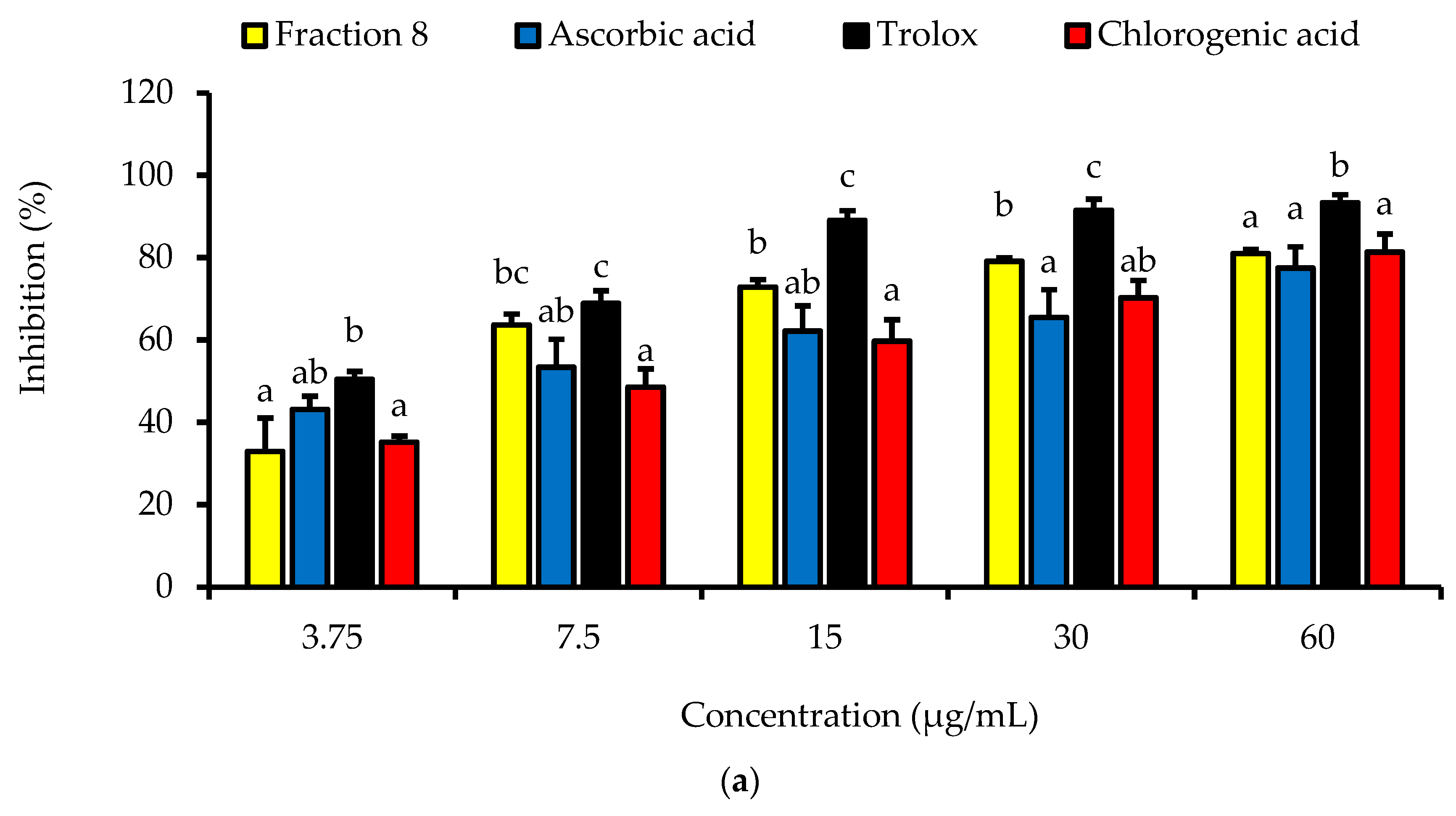

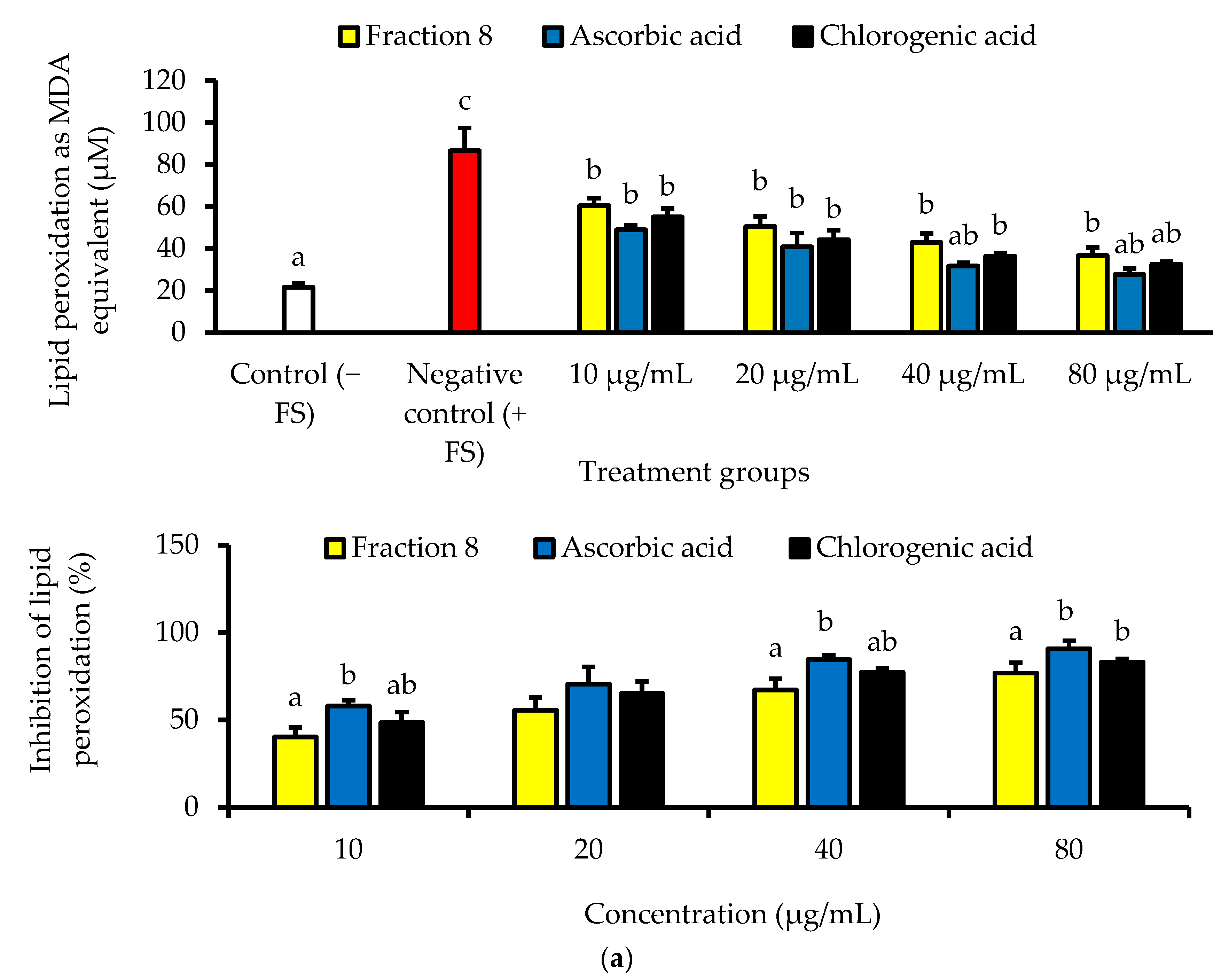
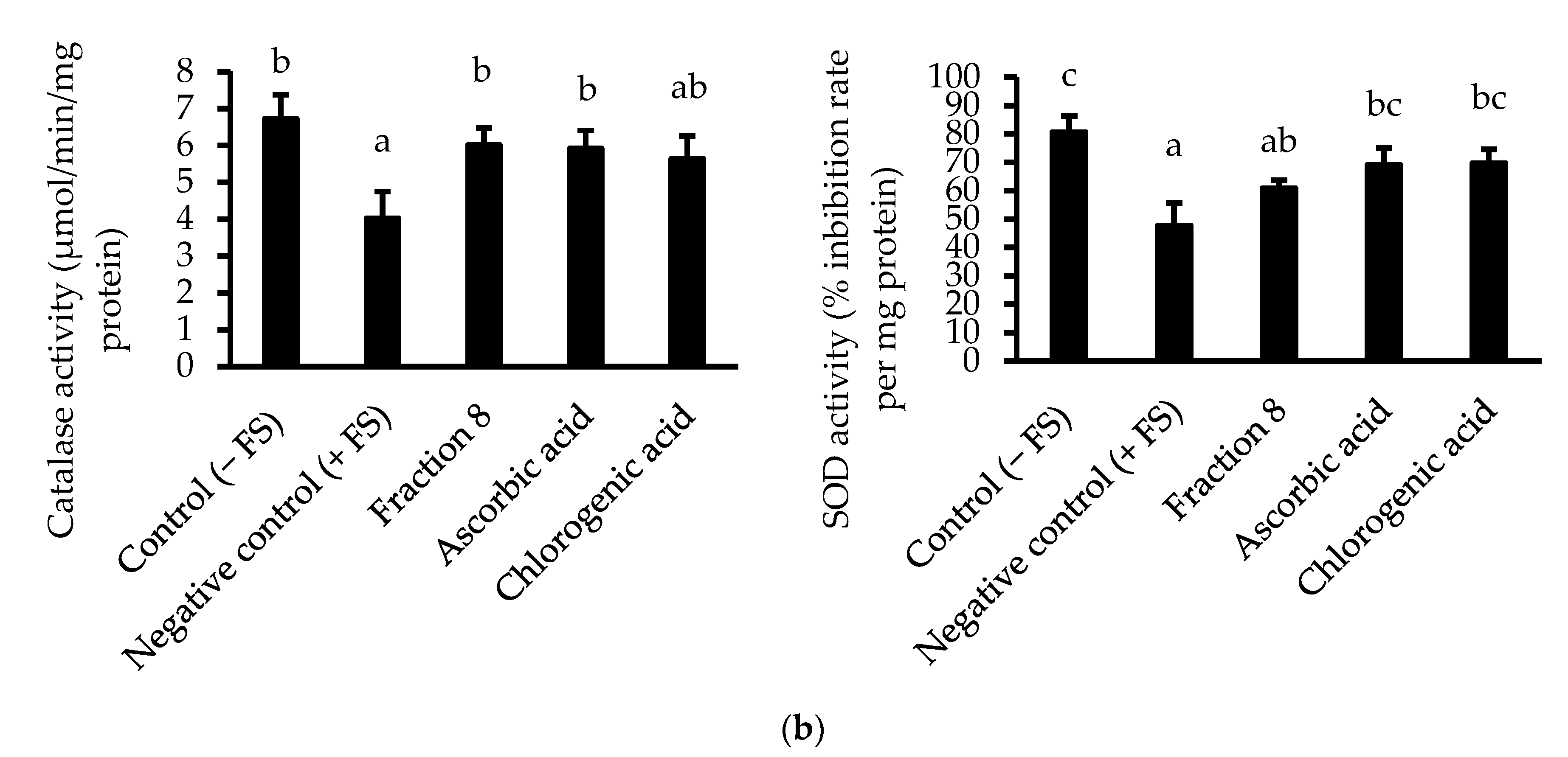
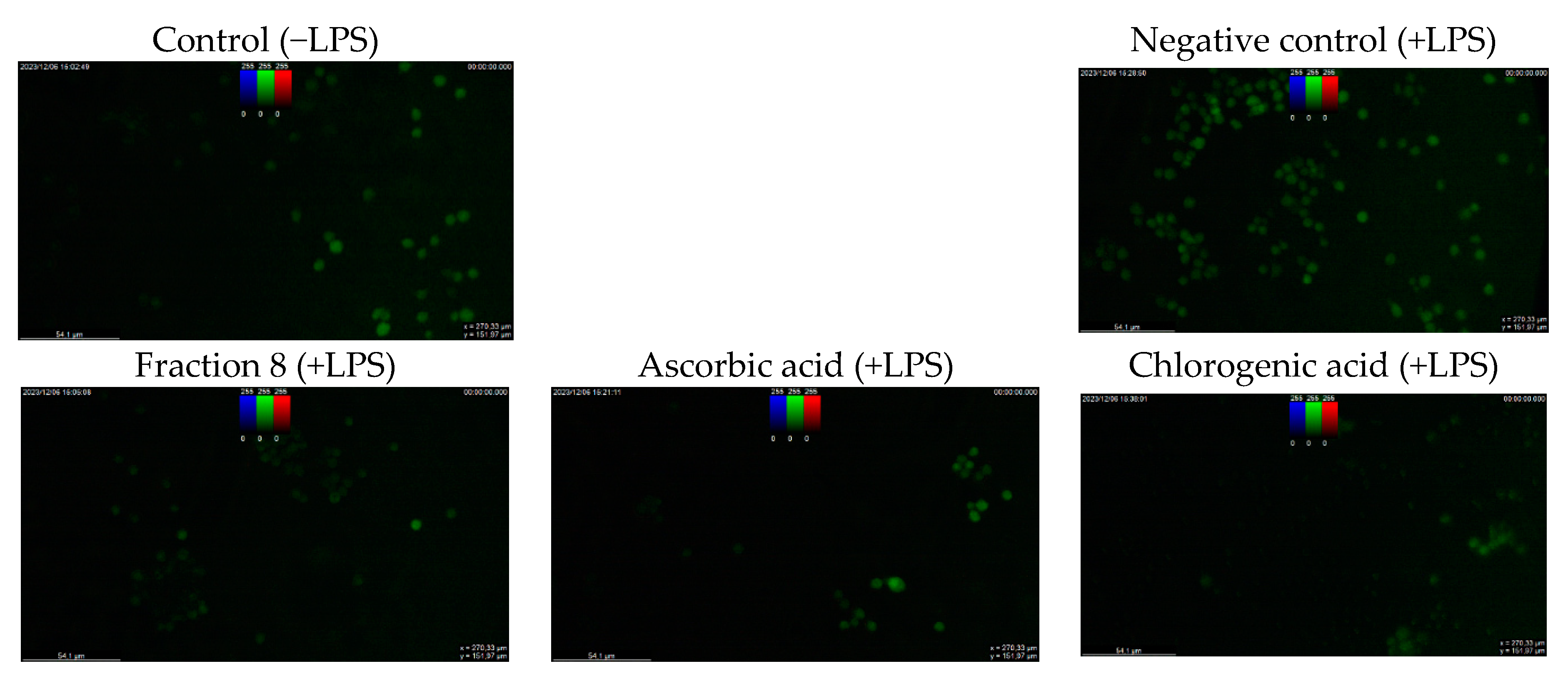




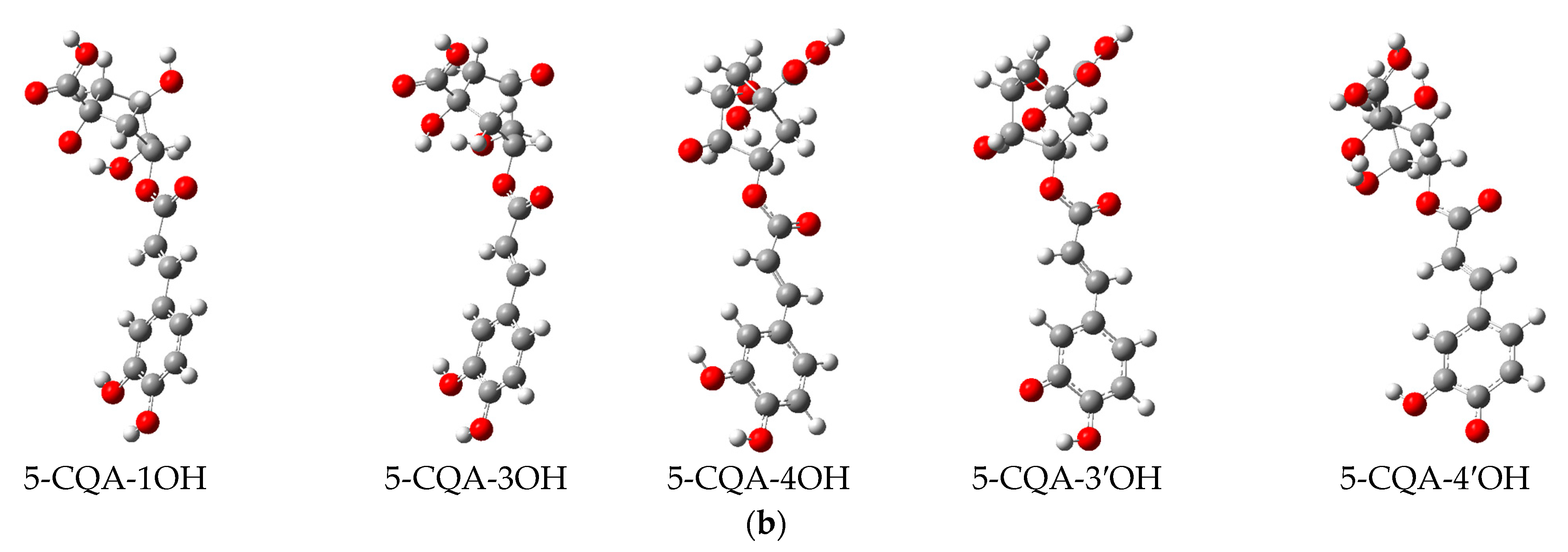
| Groups | Total Phenol Content (mg/g GAE) | Total Flavonoid Content (mg/g QE) | Fe3+ Antioxidant Capacity (mg/g GAE) | DPPH Radical Scavenging Activity (%) | ABTS Radical Scavenging Activity (%) | NO Radical Scavenging Activity (%) |
|---|---|---|---|---|---|---|
| DCM | 612 ± 48.2 b | 6.94 ± 0.76 a | 163 ± 0.61 b | 68.1 ± 5.80 b | 55.0 ± 5.31 b | 52.9 ± 2.26 d |
| EtAc | 142 ± 3.60 a | 15.8 ± 2.24 b | 31.8 ± 1.95 a | 29.1 ± 1.26 a | 31.8 ± 3.98 a | 33.4 ± 4.78 c |
| MeOH | 829 ± 48.6 c | 8.17 ± 0.60 a | 162 ± 0.42 b | 93.9 ± 2.79 c | 96.3 ± 3.14 c | 62.6 ± 3.03 d |
| Water | 157 ± 2.62 a | 7.49 ± 0.19 a | 38.7 ± 0.16 a | 35.2 ± 1.80 a | 40.8 ± 0,96 a | 29.8 ± 6.51 bc |
| Asc | N/A | N/A | 253 ± 28.1 c | 87.5 ± 5.86 c | 99.8 ± 0.16 c | 11.1 ± 3.46 a |
| Trolox | N/A | N/A | 57.1 ± 4.77 a | 94.6 ± 1.25 c | 98.1 ± 3.10 c | 20.0 ± 2.21 ab |
| Groups | Total Phenol Content (mg/g GAE) | Total Flavonoid Content (mg/g QE) | DPPH Radical Scavenging (%) | ABTS Radical Scavenging (%) | Fe3+ Antioxidant Capacity (mg/g GAE) |
|---|---|---|---|---|---|
| F2 | 195 ± 1.42 ab | 17.1 ± 4.00 ab | 44.2 ± 1.57 bc | 13.7 ± 0.21 b | 24.8 ± 3.75 ab |
| F3 | 238 ± 12.5 bc | 47.3 ± 4.10 cd | 55.6 ± 1.03 c | 40.9 ± 3.03 f | 45.2 ± 2.52 b |
| F4 | 175 ± 4.21 a | 84.45 ± 12.4 e | 40.8 ± 1.37 ab | 44.5 ± 0.03 f | 46.4 ± 0.51 b |
| F5 | 236 ± 10.6 bc | 8.04 ± 3.05 a | 32.5 ± 5.6 a | 30.1 ± 0.65 e | 29.6 ± 0.51 ab |
| F6 | 252 ± 10.1 cd | 29.3 ± 8.10 bc | 43.2 ± 5.64 ab | 22.5 ± 1.53 d | 30.6 ± 6.49 ab |
| F7 | 339 ± 3.60 e | 63.7 ± 14.9 de | 68.8 ± 1.26 d | 6.57 ± 0.01 a | 25.6 ± 1.26 ab |
| F8 | 519 ± 48.6 f | 39.4 ± 5.28 bc | 90.8 ± 9.10 e | 89.4 ± 4.65 g | 96.7 ± 15.9 c |
| F9 | 288 ± 11.2 d | 7.00 ± 0.40 a | 51.9 ± 2.87 bc | 15.4 ± 0.65 bc | 19.0 ± 2.83 a |
| F10 | 179 ± 18.7 a | 23.6 ±7.47 ab | 44.7 ± 0.33 b | 20.6 ± 1.32 cd | 44.3 ± 17.7 b |
| Asc | N/A | N/A | 85.5 ± 1.32 e | 99.4 ± 0.15 h | ND |
| Trolox | N/A | N/A | 90.5 ± 2.52 e | 99.9 ± 0.06 h | 89.1 ± 13.0 c |
| Identified Compounds | Ontology | ART (min) | AMz | Average Conc. (mg/L) |
|---|---|---|---|---|
| 4-Hydroxy-3-prenylbenzoic acid glucoside | Phenolic glycosides | 3.176 | 413.14206 | 0.1 |
| Microperfuranone | Butenolides | 3.423 | 265.08621 | 0.5 |
| Eudesmic acid | Gallic acid and derivatives | 4.359 | 211.05984 | 0.1 |
| Butalactin | Gamma butyrolactones | 4.554 | 241.07141 | 0.1 |
| Chlorogenic acid | Quinic acids and derivatives | 4.72 | 353.08762 | 103.5 |
| 4-Hydroxybenzoic acid | Hydroxybenzoic acid derivatives | 4.917 | 137.02409 | 0.1 |
| Mycophenolic acid | Phthalides | 5.014 | 319.12024 | 0.1 |
| 1-O-caffeoylquinic acid | Quinic acids and derivatives | 5.029 | 353.0867 | 102.3 |
| Caffeic acid | Hydroxycinnamic acids | 5.164 | 179.0349 | 1.0 |
| Quercetin 3-lathyroside | Flavonoid-3-O-glycosides | 5.445 | 595.1261 | 21.9 |
| Rutin | Flavonoid-3-O-glycosides | 5.671 | 609.14667 | 1.0 |
| Quercetin 3-galactoside | Flavonoid-3-O-glycosides | 5.816 | 463.08737 | 30.0 |
| Crepidiaside A | O-glycosyl compounds | 5.868 | 421.14926 | 0.1 |
| Gibberellin A17 | C20-gibberellin 20-carboxylic acids | 6.048 | 377.16031 | 0.1 |
| Quercetin 3-[rhamnosyl-(1->2)-alpha-L-arabinopyranoside] | Flavonoid-3-O-glycosides | 6.055 | 579.13745 | 14.2 |
| Quercitrin | Flavonoid-3-O-glycosides | 6.145 | 447.09045 | 43.4 |
| Azelaic acid | Medium-chain fatty acids | 6.41 | 187.09761 | 16.2 |
| 3-[4-[1-(4-Hydroxy-3-methoxyphenyl)-1.3-dihydroxyisopropoxy]-2-hydroxyphenyl]propyl alpha-L-rhamnopyranoside | Lignan glycosides | 6.426 | 509.20142 | 0.1 |
| Quercetin | Flavonols | 6.978 | 301.03497 | 3.0 |
| Corchorifatty acid F | Lineolic acids and derivatives | 7.748 | 327.21799 | 0.1 |
| Acrostalidic acid | Naphthopyrans | 10.332 | 277.1442 | 5.4 |
| Kopetdaghin A | Sesquiterpenoids | 10.488 | 383.22238 | 0.5 |
| Xanthoxin | Sesquiterpenoids | 11.134 | 249.14981 | 16.5 |
| etretinate | Retinoid esters | 11.38 | 353.21255 | 4.2 |
| 3-Oxo-4.6-choladienoic acid | Bile acids. alcohols and derivatives | 12.203 | 369.24011 | 3.4 |
| 1.1′-[1.11-Undecanediylbis(oxy)]bisbenzene | Phenol ethers | 13.462 | 339.23151 | 108.8 |
| Canrenone | Steroid lactones | 14.821 | 339.19983 | 10.9 |
| Assays | Fraction 8 | Ascorbic Acid | Trolox | Chlorogenic Acid |
|---|---|---|---|---|
| IC50 Values (µg/mL) | ||||
| DPPH radical scavenging | 5.59 ± 1.75 ab | 6.50 ± 2.18 ab | 2.41 ± 0.46 b | 8.84 ± 1.44 a |
| Anti-linoleic acid peroxidation | 5.73 ± 1.10 | 8.41 ± 3.33 | ND | 6.17 ± 1.26 |
| Anti-lipid peroxidation in Chang liver cells | 15.9 ± 3.16 a | 5.74 ± 0.66 b | ND | 9.34 ± 2.40 b |
| Inhibition of ROS production in RAW 264.7 cells | 39.6 ± 3.05 a | 8.08 ± 1.83 c | ND | 28.2 ± 2.50 b |
| Inhibition of NO production in RAW 264.7 cells | 63.5 ± 4.89 c | 203 ± 26.8 a | ND | 107 ± 2.06 b |
| Structure * | HAT | SET-PT | SPLET | ||
|---|---|---|---|---|---|
| BDE | AIP | PDE | PA | ETE | |
| kcal/mol | |||||
| 5-CQA-1OH | 27.6 | 22.0 | 5.6 | 14.0 | 13.6 |
| 5-CQA-3OH | 24.7 | 22.0 | 2.6 | 22.1 | 2.6 |
| 5-CQA-4OH | 27.1 | 22.0 | 5.0 | 24.1 | 3.0 |
| 5-CQA-3′OH | 2.6 | 22.0 | −19.4 | 5.0 | −2.4 |
| 5-CQA-4′OH | 2.1 | 22.0 | −19.9 | 5.3 | −3.2 |
Disclaimer/Publisher’s Note: The statements, opinions and data contained in all publications are solely those of the individual author(s) and contributor(s) and not of MDPI and/or the editor(s). MDPI and/or the editor(s) disclaim responsibility for any injury to people or property resulting from any ideas, methods, instructions or products referred to in the content. |
© 2024 by the authors. Licensee MDPI, Basel, Switzerland. This article is an open access article distributed under the terms and conditions of the Creative Commons Attribution (CC BY) license (https://creativecommons.org/licenses/by/4.0/).
Share and Cite
Izu, G.O.; Mfotie Njoya, E.; Tabakam, G.T.; Nambooze, J.; Otukile, K.P.; Tsoeu, S.E.; Fasiku, V.O.; Adegoke, A.M.; Erukainure, O.L.; Mashele, S.S.; et al. Unravelling the Influence of Chlorogenic Acid on the Antioxidant Phytochemistry of Avocado (Persea americana Mill.) Fruit Peel. Antioxidants 2024, 13, 456. https://doi.org/10.3390/antiox13040456
Izu GO, Mfotie Njoya E, Tabakam GT, Nambooze J, Otukile KP, Tsoeu SE, Fasiku VO, Adegoke AM, Erukainure OL, Mashele SS, et al. Unravelling the Influence of Chlorogenic Acid on the Antioxidant Phytochemistry of Avocado (Persea americana Mill.) Fruit Peel. Antioxidants. 2024; 13(4):456. https://doi.org/10.3390/antiox13040456
Chicago/Turabian StyleIzu, Gloria O., Emmanuel Mfotie Njoya, Gaetan T. Tabakam, Jennifer Nambooze, Kgalaletso P. Otukile, Seiso E. Tsoeu, Victoria O. Fasiku, Ayodeji M. Adegoke, Ochuko L. Erukainure, Samson S. Mashele, and et al. 2024. "Unravelling the Influence of Chlorogenic Acid on the Antioxidant Phytochemistry of Avocado (Persea americana Mill.) Fruit Peel" Antioxidants 13, no. 4: 456. https://doi.org/10.3390/antiox13040456
APA StyleIzu, G. O., Mfotie Njoya, E., Tabakam, G. T., Nambooze, J., Otukile, K. P., Tsoeu, S. E., Fasiku, V. O., Adegoke, A. M., Erukainure, O. L., Mashele, S. S., Makhafola, T. J., Sekhoacha, M. P., & Chukwuma, C. I. (2024). Unravelling the Influence of Chlorogenic Acid on the Antioxidant Phytochemistry of Avocado (Persea americana Mill.) Fruit Peel. Antioxidants, 13(4), 456. https://doi.org/10.3390/antiox13040456








